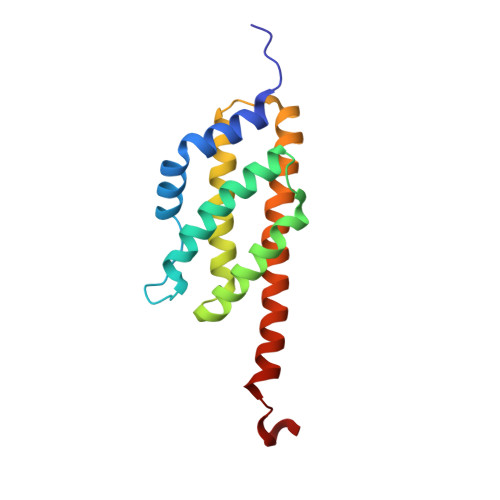Structural Insights into Inhibition of Bacillus anthracis Sporulation by a Novel Class of Non-heme Globin Sensor Domains.
Stranzl, G.R., Santelli, E., Bankston, L.A., La Clair, C., Bobkov, A., Schwarzenbacher, R., Godzik, A., Perego, M., Grynberg, M., Liddington, R.C.(2011) J Biological Chem 286: 8448-8458
- PubMed: 21216948
- DOI: https://doi.org/10.1074/jbc.M110.207126
- Primary Citation of Related Structures:
3PMC, 3PMD - PubMed Abstract:
Pathogenesis by Bacillus anthracis requires coordination between two distinct activities: plasmid-encoded virulence factor expression (which protects vegetative cells from immune surveillance during outgrowth and replication) and chromosomally encoded sporulation (required only during the final stages of infection). Sporulation is regulated by at least five sensor histidine kinases that are activated in response to various environmental cues. One of these kinases, BA2291, harbors a sensor domain that has ∼35% sequence identity with two plasmid proteins, pXO1-118 and pXO2-61. Because overexpression of pXO2-61 (or pXO1-118) inhibits sporulation of B. anthracis in a BA2291-dependent manner, and pXO2-61 expression is strongly up-regulated by the major virulence gene regulator, AtxA, it was suggested that their function is to titrate out an environmental signal that would otherwise promote untimely sporulation. To explore this hypothesis, we determined crystal structures of both plasmid-encoded proteins. We found that they adopt a dimeric globin fold but, most unusually, do not bind heme. Instead, they house a hydrophobic tunnel and hydrophilic chamber that are occupied by fatty acid, which engages a conserved arginine and chloride ion via its carboxyl head group. In vivo, these domains may therefore recognize changes in fatty acid synthesis, chloride ion concentration, and/or pH. Structure-based comparisons with BA2291 suggest that it binds ligand and dimerizes in an analogous fashion, consistent with the titration hypothesis. Analysis of newly sequenced bacterial genomes points to the existence of a much broader family of non-heme, globin-based sensor domains, with related but distinct functionalities, that may have evolved from an ancestral heme-linked globin.
- From the Infectious and Inflammatory Disease Center, Sanford-Burnham Medical Research Institute, La Jolla, California 92037.
Organizational Affiliation:


















